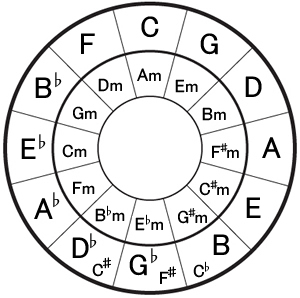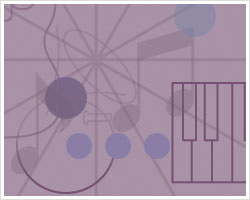
Music is full of patterns, and some of the most fundamental of those patterns can be illustrated using a diagram known as the Circle of Fifths (sometimes called the Circle of Fourths).
The Circle is a visual representation of the basic relationships between keys, chords and scales. At the top of the circle you will find the key C major on the outside (and A minor on the inside). This key signature contains no sharps or flats. Now move one step clockwise, and you will find the key of G major (and E minor). Note that the interval from C to G is a perfect fifth up (or a perfect fourth down), and the key signature for this key contains one sharp. Go another step clockwise, and you'll find D major, which is a perfect fifth up from G and has two sharps in the key signature.
See the pattern? As you move clockwise around the circle, each key is a perfect fifth up from the preceding key, and each key signature has one additional sharp. It works the same way going counter clockwise as well, except this time the motion is downward in fifths (or upward in fourths). From C to F is a perfect fourth up, taking us to a key signature that has one flat. Another fourth up, and we are at Bb, which as two flats in the key signature, and so forth.
Notice that the circle clearly illustrates the relationship of one key to another. The closer two keys are on the circle, the more notes they have in common. Notice also that for any major key on the circle, you can take the tonic chord of that key as the I, and you will find the IV right next to it (moving counter-clockwise), as well as the V chord (on the other side, moving clockwise).
Look at the minor chords (keys) on the inside of these three, and you will find your IIm, IIIm and VIm chords. Not surprisingly, these six chords are the ones that you are most likely to encounter in any given piece of music.
See also: Wikipedia: Circle of Fifths
Traditionally, music students have learned the Circle of Fifths by writing it out on a sheet of paper over and over again. We've designed a much more modern (and fun!) way of learning the Circle. As you progress through the levels of Key Puzzles, you will hear music in a wide variety of styles where the chords progress in fifths around the circle. Not only will you be learning these key patterns and relationships, but at the same time you will be subconsciously conditioning your ear to hear and recognize chord progressions that move in fifths (or fourths). This progression is one of the most frequently occurring harmonic patterns in virtually all styles of music.

